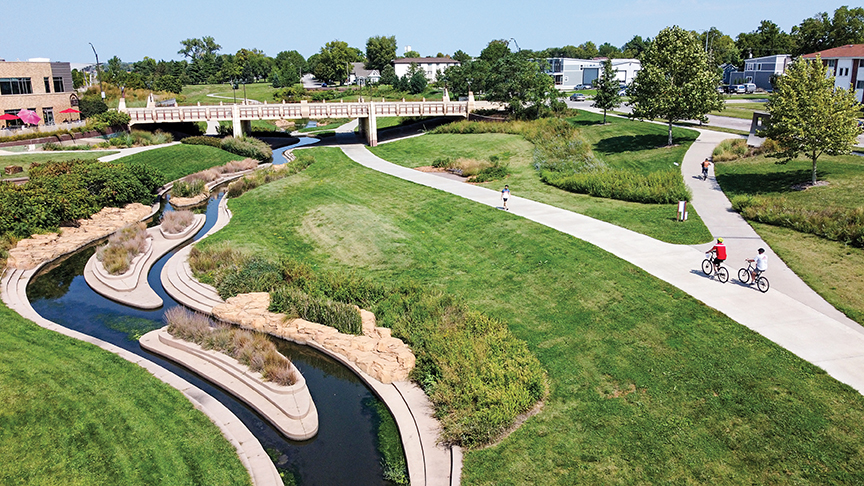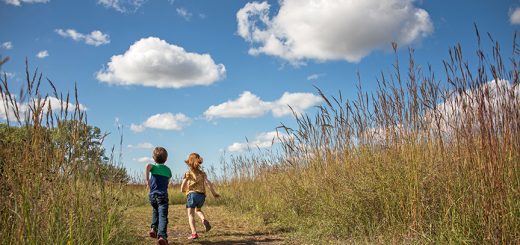Go Outside! Lincoln’s Parks & Trails

by Julie Nichols, photography by Tom Tidball
Plein air exercise
Lincoln’s newest exercise adventure isn’t in the gym, but in Woods Park, a centrally located public park, free and accessible to all. Imagine working up a sweat on an elliptical underneath a cloudless blue sky instead of with a roof overhead. FitLot, an open-air exercise area with pull-up bars and stationary steps and other exercise stations, sits near the center of Woods Park, on the park’s western edge near the picnic shelter and children’s playground. It is the gift of AARP, as part of its effort to put one FitLot in each of the 50 states. AARP has also donated funds for three years of group classes through Lincoln Parks and Recreation. But you don’t need a class to get started; signage displays proper usage of the equipment and a QR code lets smartphone users tune into videos that illustrate how to work each station. Let your next indoor exercise be outdoors in the city’s largest outdoor fitness park!
Woods Park is located just southwest of 33rd and O streets, and there is plenty of on-site parking. For group class information, search Fitlot at parks.lincoln.ne.gov.
Miles of Trails
Known as a bike-friendly city, Lincoln offers more than 25 trails, tempting riders with everything from urban commuter tracks and neighborhood loops to challenging long treks through natural landscapes to a new, 2-mile, one-track mountain bike trail. As 2021 brought more people outdoors to socialize, Lincoln’s extensive trail system of 134 miles of hard surface and crushed rock, saw heavy use.
Built for multiple uses and well maintained, the trail system is great for dog walks, jogging and commuting. Like many states, Nebraska continues to build more links to regional trails and connection to the Omaha trail system, while providing options for cross-country rides that will soon lead to the Kansas border. The national trend to build trails on former railways is how Lincoln’s MOPAC and Rock Island trails came to be.
Equestrian trails are not common, but there is a historic bridle path in Pioneers Park, shared trails in Wilderness Park as well as an unmarked horseback trail beginning at 98th Street off the MOPAC East trail. Additionally, horse camping is available at Branched Oak Lake State Recreation Area’s Homestead Campground with 15 trailer sites with electric, 14 corrals, pump water, primitive toilets, eight equestrian basic sites and three miles of trails around this large lake. Branched Oak is also a popular fishing, boating and hiking area, with a marina, rental boats, concessions and a bar and grill.
Whether looking for a neighborhood ride or the challenge of a 30-mile trek, Lincoln’s area trails connect city to wilderness. For information and maps, see Great Plains Trails Network or Nebraska Trails Foundation.
University of Nebraska Gardens/Maxwell Arboretum
For a pleasant stroll, the Maxwell Arboretum displays specialized collections of woody plants, trial sites for new cultivars and mass plantings of prairie natives and ornamental plants. Earl G. Maxwell began planting trees on his farm 50 years ago on what became University of Nebraska’s East Campus, home of agricultural and natural resources studies. Maxwell’s trees became the seed for this diverse five-acre woodland of specimen trees, including a collection of massive oaks. Sectors of the arboretum are dedicated to test gardens integrated with special collections of hosta, lilacs, iris and viburnum. With mulch paths, picnic tables, shade and open spaces, this array of gardens is family-friendly.
For more information about UNL’s gardens, Maxwell Arboretum and the Nebraska Statewide Arboretum, see www.unl.edu/bga/home.
Union Plaza/Antelope Valley Corridor
Located at 21st and O streets, and built in partnership with
the Antelope Valley Flood and Roadway project, Union Plaza connects urban trail systems with an outdoor plaza, festival space and amphitheater.
The park’s design reflects the pervasiveness of water, following a guided stream with curving walkways echoing the original routes of streambeds. Permeable pavement and run-off structures carry rainfall to streetside trees, underscoring Lincoln’s commitment to conservation. Segments of the park emphasize Nebraska’s ecosystems, with native flora and fauna represented in the retaining walls. Other murals depict the First Peoples and Nebraska’s early settlers.
On the west side, a massive stone head with an inscrutable gaze, Groundwater Colossus (James Tyler) embodies Nebraska’s Ogallala Aquifer, the largest underground water source in North America. Sounds of trickling water and clanging metal emanate from the Colossus, an illustration of the value of water and the impacts of human industry on nature. On the east side, Discover (Shannon Hansen) gives visitors a view of the State Capitol through its frame.
Union Plaza/Antelope Valley’s water control capabilities have been established through recent floods. A hub for Lincoln’s bike trail network, cyclists and pedestrians share looping trails along the waterway, and the park has stimulated nearby development and neighborhood unity.
The Jane Snyder Trails Center on 21st Street provides trail guidance and maps, rental bikes, a meeting space and public restrooms. Attached to the Trail Center, Hub Café serves innovative dishes featuring farm to table ingredients, a delicious start or finish for visitors. An outdoor dining space provides an overlook to the park.
For more information on events or amenities, visit the website at www.LincolnUnionPlaza.org. Parking is available at Hub Café/Jane Snyder Center or by the playground north of P Street.
Spring Creek Prairie
A few miles southwest of Lincoln, over 600 acres of native tallgrass prairie dominate the Spring Creek Prairie Audubon Center and Preserve. Once the primary environment of the plains region, only two percent of Nebraska’s tallgrass historical range has survived human impact. Dotted with thickets, ponds and wetlands, Spring Creek Prairie presents Nebraska’s raw nature through winding trails, historic wagon ruts and a myriad of wildlife observable in a true slice of the prairie world.
Popular with hikers and bird enthusiasts, Spring Creek Prairie joins a growing number of centers supported by the National Audubon Society, offering programs and event space throughout the year. The wildest of our regional parks, this preserve is worth the short drive southwest of the city at 11700 SW 100th Street near Denton.
For more information see springcreek.audubon.org.
Pioneers Park
For a hike, bike ride or a drive, Pioneers Park exhibits wetland, prairie and forest habitat, rescued raptors, bison, elk and white-tailed deer. Whether you are seeking contemplation or knowledge of Nebraska’s prairies and wildlife, Pioneers Park satisfies.
A year-round destination, Pioneers Park offers visitors an array of activities focused on enjoyment of Nebraska’s natural world. Located on the southwest edge of Lincoln, the park contains nature trails, playgrounds, prairie, picnic structures and a sledding hill. Trails through grassland and forest accommodate pedestrians, cyclists and equestrians.
One of Lincoln’s most popular sculptures, a life-sized bronze bison marks the main park entrance on West Van Dorn Street. Another sculpture, Smoke Signal, captures Chief Red Cloud raising his blanket over a signal fire. Dedicated in 1935 in the presence of four Native American men on horseback, Smoke Signal is placed on the crest of a hill and offers visitors a panorama of the park.
A favorite of photographers, the ionic style Treasury Columns stand near woods at the bottom of a sweeping hill on the north side of the park. Four of 30 original Federal Treasury columns were shipped and installed at great cost in honor of Nebraska’s famed politician, William Jennings Bryan.
Pioneers Park Nature Center, originally a 40-acre wildlife preserve called the Chet Ager Bird and Wildlife Nature Study Sanctuary, has expanded over 60 years to two interpretive centers and 668 acres of habitat. Chet Ager Center houses a collection of Nebraska fauna, including reptiles and amphibians. Across the road, the Prairie Building provides classrooms, auditorium and exhibit space for the Nature Center’s education programs. Built for sustainability, the Prairie Building is adjacent to the Hands-on Prairie, a restored tall-grass ecosystem.
Nature programs led by staff occur year-round for groups and visitors. Each fourth grader in Lincoln Public Schools attends a Heritage School day in a restored one-room schoolhouse set in the tallgrass prairie. The Nature Center’s preschool program teaches through direct contact with the outdoors and its creatures: kids get dirty, touch a snake’s skin, see birds in flight, and observe life cycles of insects and plants. Each year, families plant a butterfly garden to attract pollinators.
Admission is free; donations accepted.
Hours: Monday through Saturday, 9 a.m.-4:30 p.m.; Sundays noon to 4:30 p.m. Closed Thanksgiving, Christmas and New Year’s.
Traffic entrances are Coddington Street (east) or West Van Dorn Street (north). Find a map download at lincoln.ne.gov/city/parks/naturecenter/links/trailmap.pdf, or call the Nature Center at (402) 441-7895 for information.
Wilderness Park
Wilderness Park lives up to its name. Minimally developed, its topography and accessibility change with seasonal shifts in Salt Creek’s flooding and erosion. Separated into several sections southwest of Lincoln totaling 1,500 acres, this park is the largest nature conservancy in the Lincoln area. A haven for naturalists and those seeking escape from the city, the thick woodlands provide habitat for an array of wildlife: foxes, deer, raccoon, songbirds, owls, frogs, small fish and aquatic invertebrates. Under the canopy, shade plants and fungi thrive.
A 10-mile network of dirt and limestone trails, single-track and horse trails weave through the park, each marked for use. Wilderness Park trails connect with Jamaica Trail North to the Homestead Trail corridor, which takes cyclists over 40 miles south to Beatrice and will ultimately extend to Marysville, Kansas.
Wilderness Park’s segments lie between South 1st Street (west side), Van Dorn Street (north), 27th Street (east) and Saltillo Road (south), where the park is the widest…and the wildest.
A natural retreat year-round, Wilderness Park is free. For information on facilities, parking and trail access, see lincoln.ne.gov/city/parks/parksfacilities/parks/wilderness.htm.
Hiking and Biking Nearby
With mountain bike and hiking trails, Platte River State Park leads visitors to the picturesque Stone Creek Falls. The state park is also home to observation towers with spectacular views of the Platte River and Eugene T. Mahoney State Park just across the river. A lodge and restaurant, modern campground, vintage and ”glamping” cabins, spray park, playgrounds and horse rides offer activities for the whole family.
Along with fantastic hiking and biking trails, Eugene T. Mahoney State Park includes an aquatic center and indoor playground, and winter skating and sledding. Halfway between Lincoln and Omaha, the park is open year-round, about 30 minutes from Lincoln. Cabin and lodge accommodations are available year-round.
For information: outdoornebraska.gov/stateparks/.













Recent Comments